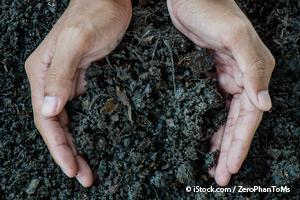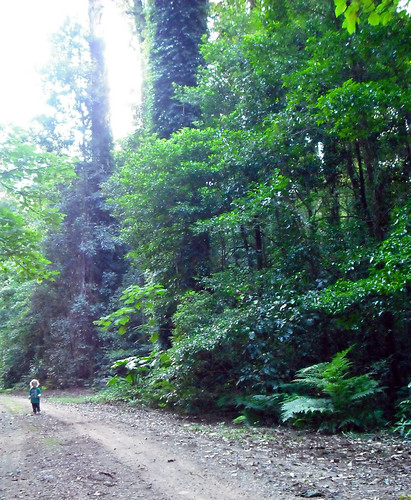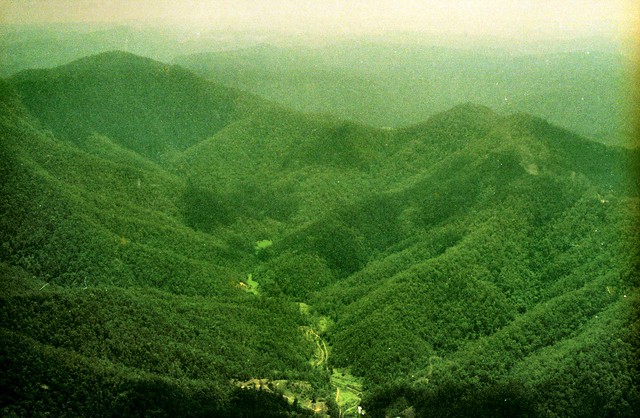Soil Is the Solution
Saving the Earth

By Dr. Mercola
It's easy to take soil for granted. That is, until you lose it. The dirt beneath your feet is arguably one of the most under-appreciated assets on the planet. Without it, life would largely cease to exist while, when at its prime, this "black gold" gives life.
In nature, plants thrive because of a symbiotic relationship with their surrounding environment, including microorganisms in the soil.
The rhizosphere is the area immediately around a plant's root. It contains microorganisms that thrive on chemicals released from the plant's roots. These chemicals, known as exudates, include carbohydrates, phytochemicals and other compounds.
In exchange for the exudates, the root microbiome supplies the plant with important metabolites for health, which, along with exposure to pests and pathogens, helps plants produce phytochemicals.
A well-fed root microbiome will also supply plants with ample nitrogen (N), phosphorus (P) and potassium (K) — the three ingredients that also make up most synthetic fertilizer (NPK).
Unfortunately, while nature's system results in handsome rewards, including more nutritious foods and less environmental pollution, modern-day farmers have largely become stuck in a cycle of dousing crops with synthetic chemicals that destroy the soil and, ultimately, the environment.

Why Synthetic Fertilizers Are Ruining the Planet
Synthetic fertilizers make sense in theory, and they do make plants grow bigger and faster. The problem is that the plants are not necessarily healthier. In fact, they miss out on the symbiotic relationship with their root microbiome.
Because they're being supplied with NPK, the plant no longer "wastes" energy producing exudates to feed its microbiome.
Therefore, it receives fewer metabolites for health in return. The end result is plants that look good on the outside but lack minerals, phytochemicals and defenses against pests and disease on the inside.
Further, as reported by Rick Haney, a U.S. Department of Agriculture (USDA) soil scientist, less than 50 percent of synthetic fertilizers applied to crops are used by the plants. Haney told Orion Magazine:1
"Farmers are risk averse … They've borrowed a half million dollars for a crop that could die tomorrow. The last thing they want to worry about is whether they put on enough fertilizer. They always put on too much, just to be safe."
The excess fertlizer runs off into the environment, with disastrous effects. As fertilizer runs off of farms in agricultural states like Minnesota, Iowa, Illinois, Wisconsin, Missouri and others, it enters the Mississippi River, leading to an overabundance of nutrients, including nitrogen and phosphorus, in the water.
This, in turn, leads to the development of algal blooms, which alter the food chain and deplete oxygen, leading to dead zones. One of the largest dead zones worldwide can be found in the Gulf of Mexico, beginning at the Mississippi River delta.2 Fisheries in the Gulf of Mexico have been destroyed as a result.
Soil Health Campaign Educates Farmers How to Work With Nature
USDA's Natural Resources Conservation Service (NRCS) convenes sessions around the U.S. in an effort to improve soil health and teach farmers how to use less fertilizer and produce the same, and in some cases better, yields. Haney told Orion Magazine:3
"Our entire agriculture industry is based on chemical inputs, but soil is not a chemistry set … It's a biological system. We've treated it like a chemistry set because the chemistry is easier to measure than the soil biology."
While standard soil tests measure chemical properties in the soil, Haney developed a test to measure soil biology. A rich microscopic community is what Haney is after. Only this can support the fascinatingly complex process of plant growth and, at the same time, naturally cut carbon emissions by fixing carbon in the soil.
It's estimated that one-third of the surplus carbon dioxide in the atmosphere stems from poor land-management processes that contribute to the loss of carbon, as carbon dioxide, from farmlands.4 Writing in Orion Magazine, Kristin Ohlson, author of "The Soil Will Save Us," explained:5
"When we admire good soil's dark chocolate-cake sponginess and sweet smell, we're admiring the handiwork of trillions of soil microorganisms over time.
They eat carbon and expire carbon dioxide, just as we do, but they also "fix" a percentage of that carbon in the soil. Barring disturbance, it stays there for a very long time.
… Photosynthesis is the only process that safely and inexpensively removes carbon dioxide from the atmosphere, allowing carbon that is a problem in the skies to become a boon for the land.
Based on this principle, one hundred governments and nonprofits launched the 4/1000 Initiative … calling for an increase of carbon in the world's soils by 0.4 percent per year.
This relatively small boost will not only radically improve soil fertility but also, the coalition claims, halt the annual rise of atmospheric carbon dioxide."

Three 'Game-Changing' Practices for Agriculture
Carbon farming is a simple premise that involves using agricultural methods that can naturally trap carbon dioxide in the ground (for decades, centuries or more) while also absorbing it from the air.
The process, known as "carbon sequestration," could help mitigate greenhouse gas emissions and:
| Regenerate the soil | Limit agricultural water usage with no till and crop covers |
| Increase crop yields | Reduce the need for agricultural chemicals and additives, if not eliminate such need entirely in time |
| Reduce atmospheric carbon dioxide levels | Reduce air and water pollution by lessening the need for herbicides, pesticides, and synthetic fertilizers |
A recent study published in the journal Nature further revealed that by managing soils to reduce greenhouse gases, it could lead to a wealth of "side benefits," including healthier soils and ecosystems, less fertilizer runoff and less soil erosion.6
In an interview with The Christian Science Monitor, Phil Robertson of Michigan State University explained three "game-changing" practices that could help make soils "net mitigating," meaning they capture more greenhouse gases than they emit.7
1. No-till cultivation, in which crops are grown without plowing
2. Advanced nitrogen fertilizer management, or applying only minimal amounts of fertilizer
3. Cover crops
The latter strategy alone, cover crops, can virtually eliminate the need for irrigation when done right. The cover crops also act as insulation, so the soil doesn't get as hot or cold as it would if bare. This allows microbes to thrive longer.
Also, the soil biology heats up the soil, which can extend your overall growing season in colder areas, and it helps prevent soil erosion. In 2012, a Census of Agriculture report found just over 10 million acres of farmland (out of 390 million total) were being planted with cover crops, but its use is growing.
In an annual survey of farmers taken in 2014, farmers reported planting double the mean acreage in cover crops reported in 2010.8 Farmers who adopt the technique have reported better soil texture, less erosion, and increased crop yields.
Planting Winter Cover Crops May Make Farmers Money
This is key, because convincing most farmers to change their practices solely for environmental reasons isn't an easy proposition, especially if it also involves increased costs to the farmer. Robertson recommends using conservation payments, which have been in place for decades, to pay farmers to adopt more sustainable agricultural practices.
Some farmers also change their ways after seeing the success of their neighbors' farms. Farmer Doug Anson, who along with his family plants cover crops on 13,000 of their 20,000 acres of Indiana farmland, told The New York Times:9
"In the part of a field where we had planted cover crops, we were getting 20 to 25 bushels of corn more per acre than in places where no cover crops had been planted … That showed me it made financial sense to do this."
A research project that's been ongoing for two decades in Michigan, comparing crop plots using four different farming methods, has also shown promise for cover crops. The fields that received small amounts of fertilizer and were planted with winter cover crops had yields similar to conventional fields with far less nitrogen leaching.10
The U.S. government has even set up a small subsidy system to help farmers offset the costs of cover crops and other regenerative practices, but one major hurdle to cover crops becoming mainstream involves absentee land owners.
Many farmers grow crops on land they do not own but rather lease; they therefore have little incentive to want to improve soil quality on land they do not own. Landowners could, however, offer incentives to farmers to use regenerative practices that would, in turn, increase the value of their land.11
Farmers and Landowners Can Get Paid for 'Carbon Credits'
Conventional farmers have much to gain from trying out carbon-sequestration practices like planting cover crops, applying compost and not tilling; they can accumulate, and be paid for, carbon credits.
Farmers can even use the USDA's COMET-Farm online tool to find out their approximate carbon footprint, as well as experiment to see which land-management practices sequester the most carbon on their farm.12 How does it work? Modern Farmer explained:13
"Land-based carbon sequestration is measured in metric tons per hectare (2.5 acres); one metric ton earns one carbon credit, making the math easy. In California — the only state in the US with a full-fledged cap-and-trade program — the current value of a carbon credit is around $12 to $13. (Farmers in other states, by the way, are eligible to earn credits through the California carbon market.)
Alberta, which has the most robust carbon market in Canada and rewards several agricultural practices with carbon credits, raised the price of carbon credits from $15 to $20 on January 1, 2016; in 2017, the price will go up to $30 per credit."
Unfortunately, the way the system is currently set up, farmers already using beneficial conservation practices are not eligible for carbon credits. Only those switching land from conventional agriculture to soil-conservation practices may receive credits, with the exception of spreading compost over grazed grasslands, which are used to raise grass-fed beef and other pastured animal products.
This recently approved carbon credit "protocol" was largely the result of the Marin Carbon Project, which found a single 1/2-inch dusting of compost on rangeland can boost the soil's carbon storage for at least 30 years.
If you're a farmer interested in receiving carbon credits, you'll need to sign up with a carbon credit registry such as the Climate Action Reserve, the American Carbon Registry, or and the Verified Carbon Standard. An inspector will visit your farm regularly to ensure you've carried out the protocols correctly.14

Regenerating Our Soil Is the Solution
It's clear that paying attention to our soils is crucial to our health and future. Fortunately, change is occurring both on large and small scales. The USDA's NRCS has become very committed to understanding and teaching about natural soil health and regenerative agriculture
Not only will regenerating our soils lead to improved food production, it will also address a majority of resource concerns, such as water. When you add carbon back into the soil, such as by adding mulch or cover crops, the carbon feeds mycorrhizal fungi that eventually produce glomalin, which may be even better than humic acid at retaining water. This means you naturally limit your irrigation needs and make your garden or fields more resilient during droughts.
Considering data suggesting we may lose all commercial topsoil, globally, in the next 60 years if we keep going at the current rate, such changes cannot move fast enough. The NRCS website is an excellent resource for anyone interested in learning more about soil health, including farmers wanting to change their system.
At present, about 10 percent of U.S. farmers have started incorporating practices to address soil health. Only about 2 percent have transitioned to full-on regenerative land management, however. On an individual level, you can get involved by growing some of your own food using these regenerative principles on a small scale.
From Dr Mercola @ http://articles.mercola.com/sites/articles/archive/2016/05/10/soil-regeneration-conservation-practices.aspx
Thanks to: http://nexusilluminati.blogspot.com






 Sat Mar 23, 2024 11:33 pm by globalturbo
Sat Mar 23, 2024 11:33 pm by globalturbo

